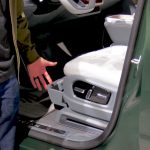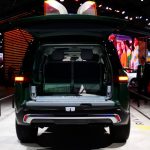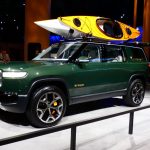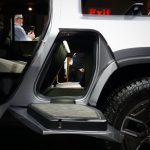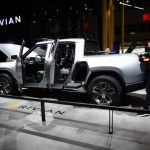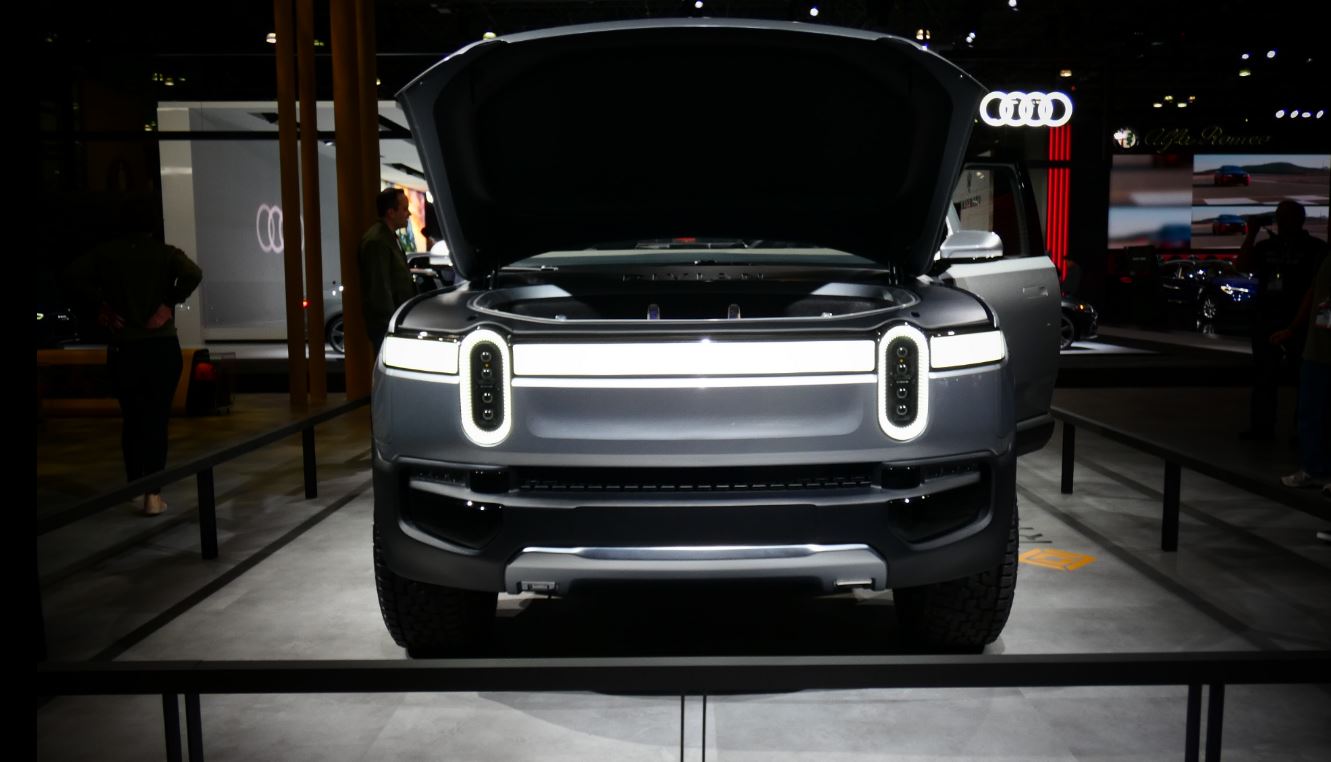
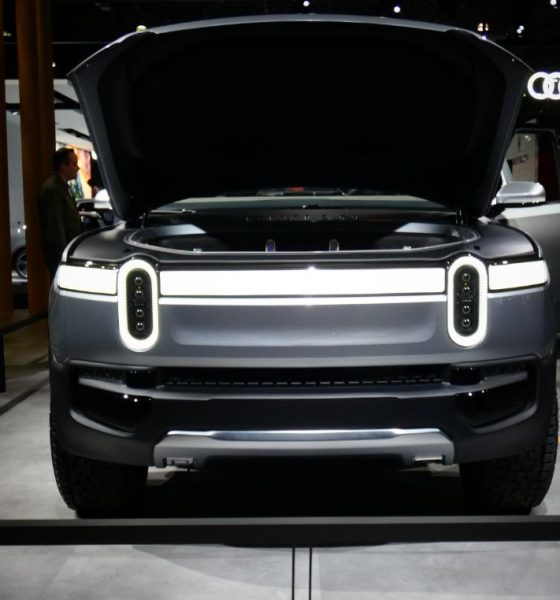
News
Rivian shows off new details at NY Auto Show before heading home
Rivian has been on a promotional whirlwind since the company came out of the shadows last year at the 2018 LA Auto Show, and with it, the all-electric adventure company’s attendance at the New York International Auto Show this year has now generated quite a few more vehicle detail revelations from interviews posted online by show attendees.
Thanks for the warm welcome, #NY! See you again soon. pic.twitter.com/RNTHh5bYy3
— Rivian (@Rivian) April 28, 2019
Brian Gase, Rivian’s Chief Engineer of Special Projects, appeared in a number of videos describing features of the R1T truck and R1S SUV that are unique and otherwise not commonly known about the vehicles.
First, the number of storage compartments were one of the smaller details that stood out. In the R1T, the back passenger seats have bins underneath the cushions, and both vehicles have sliding bins underneath the driver and shotgun seats. A full size spare tire is in the R1T bed and can be removed for even more storage if needed, but to save space for storage and its usable third row seating, the R1S has an inflatable spare tire under the trunk floor.
Rivian’s plans for interior color options were also mentioned, and there are three: Forest Edge (the green inside the demo R1T), Lunar Rock (the grey inside the demo R1S), and black. Additional premium options will be offered for interior fabrics which are already a blend of traditional materials and the types of fabrics you’d find in durable outerwear. The cabins also feature quad-zone climate control.
On the performance side, 170 kW of independent power is provided to each wheel which also provides for torque vectoring. The approximately 750-800 total horsepower in each vehicle works out to about 180 hp per wheel from each of the four motors.
- Rivian R1S SUV at New York Auto Show 2019. | Image: Dacia J. Ferris/Teslarati
- Rivian R1S SUV at New York Auto Show 2019. | Image: Dacia J. Ferris/Teslarati
- Rivian R1S SUV at New York Auto Show 2019. | Image: Dacia J. Ferris/Teslarati
Rivian’s high density battery pack, complete with a thermal control system that adapts according to charging and driving behavior, then powers the whole package. A giant battery might not seem like it would be a great choice for four-wheel adventures, but Rivian has tightly encased its vehicles’ power supply using advanced materials science to be capable of wading up to three feet of water. Since there’s no engine requiring air, only buoyancy prevents a deeper crawl.
Progress in the automotive self-driving arena is moving fast, and Rivian has already integrated that reality into the R1T and R1S designs. The camera and radar hardware on production vehicles will be capable of Level 3 autonomous driving that’s upgradable via over-the-air software updates. Rivian’s initial vehicles will ship with Level 2 capabilities and use data accumulated from its customers’ driving sent to the cloud to develop its Level 3 transition, very similar to Tesla’s strategy. Previously, Rivian has additionally suggested Jurassic Park-style autonomous tours might be available for owners wanting a guided, real-world adventure experience.
Rivian has several test mules on the road using F-150 bodies, but only one production design model of each car has been made to be used at shows and in videos.
Finally, you might know that Rivian was founded in 2009 by CEO RJ Scaringe, an MIT graduate (he holds an MS and PhD in mechanical engineering), but it seems lesser known how his personal life story is imprinted right in the company’s name. Scaringe grew up near the Indian River region of Florida, and that’s where the Rivian name is derived (RIV(er)-(Ind)IAN).

BACK TO BASICS
All of those tidbits will now join the overall more well known features driving the appeal of Rivian’s R1T truck and R1S SUV. A recap of the basics may put them into a better perspective still.
On battery packs, Rivian’s focus on outdoor adventure means that decent battery capacity and range are key components if their product ideas are to be successful, and their much-touted 180 kWh battery “megapack” boasting a 400+ mile range seems to fit that bill. The mid-range 135 kWh pack claiming a 300 mile range is also decent for well-planned routes, and it just so happens to have a fun number of 2170 battery cells – 7,777 exactly if you count the battery inside the in-door flashlight. The 135 kWh battery pack vehicles are also the versions that will do 0-60 mph in 3 seconds, although all versions are speed limited to 125 mph. A lower end 105 kWh pack with a 230 mile range will be produced last, per the usual new EV strategy of offering premium cars before more affordable variations.
https://twitter.com/PrincessDeixa/status/1118957811285811200
The first R1S and R1T deliveries are set for the end of 2020, and Rivian is currently taking preorder deposits to reserve their upcoming vehicles. Purchase prices will start at $69,000 for the R1T and $72,500 for the R1S before tax incentives.
Aside from being first to unveil a near-production all-electric pickup truck, two other features in Rivian’s electric cars have stood out. First, the quad-motor “skateboard” chassis that forms the base of current and future vehicles centralizes and simplifies Rivian’s innovations into a flexible electric car platform for its future product lines. This feature has also drawn interest from big-name partners like GM and Ford, the latter having just signed a $500 million deal with Rivian to use its tech to develop their first all-electric vehicle.
A somewhat new tidbit about the skateboard platform is the size difference between the R1S version and the R1T version. The R1S chassis is 375 mm shorter than the R1T to boost its off-road capabilities. Both vehicles’ towing capacity is around 11,000 pounds.
The second well-known feature about Rivian’s two outdoor-purposed vehicles is the amount of storage space incorporated into the designs. The frunks are spacious with a 330 mL capacity, and the R1T truck has what they call a ‘gear tunnel’, which is essentially a large cargo space tunneled through the lower middle of the truck’s cab. It looks to have the makings of the next social media photo craze, but that’s obviously speculation.
- Rivian R1T truck at the NY Auto Show 2019. | Image: Dacia J. Ferris/Teslarati
- Rivian R1T truck at the NY Auto Show 2019. | Image: Dacia J. Ferris/Teslarati
Both the frunk and tailgates have powered open and close functions for ease of use, the tailgate opening a full 180 degrees, and the bed has a powered built-in tonneau cover strong enough to support loading. Also included in the truck bed are 110V power outlets, onboard air, lights to illuminate the bed, and a gear cable that’s electronically connected to the vehicle. If the cable is cut or disconnected for any reason, the owner receives a notification on their Rivian app.
Other details to mention are the electrochromatic glass roof built into both the R1T and R1S that can change color on demand, specifically in response to outside weather and light conditions, and the daytime running lights that also act as turn signals and charging status indicator lights. A charging status indicator is also in the back of the vehicles.
Check these #rivian R1T features out! The sun roof changing colors and the height adjustable air springs in action! #NYautoshow2019 #electricvehicles #electrictruck #truck pic.twitter.com/Wc517rt8dM
— DJ (@PrincessDeixa) April 18, 2019
The last major Rivian feature to mention is the adaptable air suspension. Both vehicles’ ride height can be easily raised or lowered depending on road conditions to adjust comfort and handling characteristics. There’s even a ‘kneel’ mode to ease vehicle entry and exit.
STILL TO COME
Rivian’s R1T truck and R1S SUV already have enough innovative details to drive their consumer appeal as-is, but the company has even more developments going on in the background. Recently published patent applications have revealed a modular system for swapping out vehicle components based on activity need and a digital jerry can to extend the battery range even further for longer trips away from a charging network.
Additionally, trademark applications filed with the US Patent and Trademark Office have teased several other products in the works with names like 1C, 1A, and 2R. An interview with RJ Scaringe published by Bloomberg confirmed that Rivian is indeed working on six other products.
Details surrounding Rivian’s plans for a service network are still slim despite the abundance of other important information about the Michigan-based company. The R1S and R1T vehicles will use CCS charging ports, but whether a charging partnership or a home-grown effort is planned remains to be seen.
A NY International Auto Show attendee recently posted on Reddit details gathered from speaking with Rivian’s team, including Scaringe, and indications were made that the company is interested in using Tesla’s Superchargers, although they’ve had some difficulties with the effort. A potential roadshow tour offering test drives was also mentioned.
A couple of the Rivian video interviews can be watched below:

Elon Musk
Elon Musk’s X will start using a Tesla-like software update strategy
The initiative seems designed to accelerate updates to the social media platform, while maintaining maximum transparency.

Elon Musk’s social media platform X will adopt a Tesla-esque approach to software updates for its algorithm.
The initiative seems designed to accelerate updates to the social media platform, while maintaining maximum transparency.
X’s updates to its updates
As per Musk in a post on X, the social media company will be making a new algorithm to determine what organic and advertising posts are recommended to users. These updates would then be repeated every four weeks.
“We will make the new 𝕏 algorithm, including all code used to determine what organic and advertising posts are recommended to users, open source in 7 days. This will be repeated every 4 weeks, with comprehensive developer notes, to help you understand what changed,” Musk wrote in his post.
The initiative somewhat mirrors Tesla’s over-the-air update model, where vehicle software is regularly refined and pushed to users with detailed release notes. This should allow users to better understand the details of X’s every update and foster a healthy feedback loop for the social media platform.
xAI and X
X, formerly Twitter, has been acquired by Elon Musk’s artificial intelligence startup, xAI last year. Since then, xAI has seen a rapid rise in valuation. Following the company’s the company’s upsized $20 billion Series E funding round, estimates now suggest that xAI is worth tens about $230 to $235 billion. That’s several times larger than Tesla when Elon Musk received his controversial 2018 CEO Performance Award.
As per xAI, the Series E funding round attracted a diverse group of investors, including Valor Equity Partners, Stepstone Group, Fidelity Management & Research Company, Qatar Investment Authority, MGX, and Baron Capital Group, among others. Strategic partners NVIDIA and Cisco Investments also continued support for building the world’s largest GPU clusters.
News
Tesla FSD Supervised wins MotorTrend’s Best Driver Assistance Award
The decision marks a notable reversal for the publication from prior years, with judges citing major real-world improvements that pushed Tesla’s latest FSD software ahead of every competing ADAS system.

Tesla’s Full Self-Driving (Supervised) system has been named the best driver-assistance technology on the market, earning top honors at the 2026 MotorTrend Best Tech Awards.
The decision marks a notable reversal for the publication from prior years, with judges citing major real-world improvements that pushed Tesla’s latest FSD software ahead of every competing ADAS system. And it wasn’t even close.
MotorTrend reverses course
MotorTrend awarded Tesla FSD (Supervised) its 2026 Best Tech Driver Assistance title after extensive testing of the latest v14 software. The publication acknowledged that it had previously criticized earlier versions of FSD for erratic behavior and near-miss incidents, ultimately favoring rivals such as GM’s Super Cruise in earlier evaluations.
According to MotorTrend, the newest iteration of FSD resolved many of those shortcomings. Testers said v14 showed far smoother behavior in complex urban scenarios, including unprotected left turns, traffic circles, emergency vehicles, and dense city streets. While the system still requires constant driver supervision, judges concluded that no other advanced driver-assistance system currently matches its breadth of capability.
Unlike rival systems that rely on combinations of cameras, radar, lidar, and mapped highways, Tesla’s FSD operates using a camera-only approach and is capable of driving on city streets, rural roads, and freeways. MotorTrend stated that pure utility, the ability to handle nearly all road types, ultimately separated FSD from competitors like Ford BlueCruise, GM Super Cruise, and BMW’s Highway Assistant.
High cost and high capability
MotorTrend also addressed FSD’s pricing, which remains significantly higher than rival systems. Tesla currently charges $8,000 for a one-time purchase or $99 per month for a subscription, compared with far lower upfront and subscription costs from other automakers. The publication noted that the premium is justified given FSD’s unmatched scope and continuous software evolution.
Safety remained a central focus of the evaluation. While testers reported collision-free operation over thousands of miles, they noted ongoing concerns around FSD’s configurable driving modes, including options that allow aggressive driving and speeds beyond posted limits. MotorTrend emphasized that, like all Level 2 systems, FSD still depends on a fully attentive human driver at all times.
Despite those caveats, the publication concluded that Tesla’s rapid software progress fundamentally reshaped the competitive landscape. For drivers seeking the most capable hands-on driver-assistance system available today, MotorTrend concluded Tesla FSD (Supervised) now stands alone at the top.
News
Elon Musk’s Grokipedia surges to 5.6M articles, almost 79% of English Wikipedia
The explosive growth marks a major milestone for the AI-powered online encyclopedia, which was launched by Elon Musk’s xAI just months ago.

Elon Musk’s Grokipedia has grown to an impressive 5,615,201 articles as of today, closing in on 79% of the English Wikipedia’s current total of 7,119,376 articles.
The explosive growth marks a major milestone for the AI-powered online encyclopedia, which was launched by Elon Musk’s xAI just months ago. Needless to say, it would only be a matter of time before Grokipedia exceeds English Wikipedia in sheer volume.
Grokipedia’s rapid growth
xAI’s vision for Grokipedia emphasizes neutrality, while Grok’s reasoning capabilities allow for fast drafting and fact-checking. When Elon Musk announced the initiative in late September 2025, he noted that Grokipedia would be an improvement to Wikipedia because it would be designed to avoid bias.
At the time, Musk noted that Grokipedia “is a necessary step towards the xAI goal of understanding the Universe.”
Grokipedia was launched in late October, and while xAI was careful to list it only as Version 0.1 at the time, the online encyclopedia immediately earned praise. Wikipedia co-founder Larry Sanger highlighted the project’s innovative approach, noting how it leverages AI to fill knowledge gaps and enable rapid updates. Netizens also observed how Grokipedia tends to present articles in a more objective manner compared to Wikipedia, which is edited by humans.
Elon Musk’s ambitious plans
With 5,615,201 total articles, Grokipedia has now grown to almost 79% of English Wikipedia’s article base. This is incredibly quick, though Grokipedia remains text-only for now. xAI, for its part, has now updated the online encyclopedia’s iteration to v0.2.
Elon Musk has shared bold ideas for Grokipedia, including sending a record of the entire knowledge base to space as part of xAI’s mission to preserve and expand human understanding. At some point, Musk stated that Grokipedia will be renamed to Encyclopedia Galactica, and it will be sent to the cosmos.
“When Grokipedia is good enough (long way to go), we will change the name to Encyclopedia Galactica. It will be an open source distillation of all knowledge, including audio, images and video. Join xAI to help build the sci-fi version of the Library of Alexandria!” Musk wrote, adding in a later post that “Copies will be etched in stone and sent to the Moon, Mars and beyond. This time, it will not be lost.”
